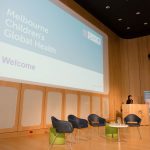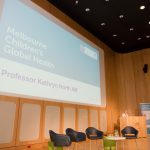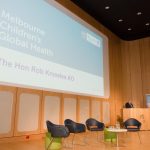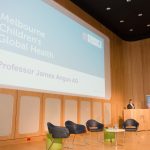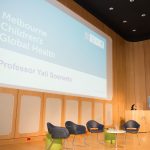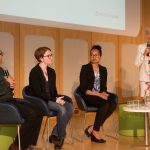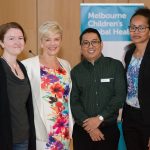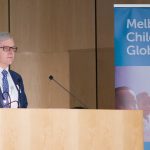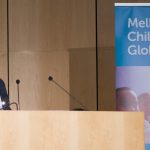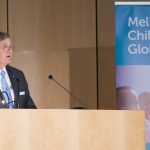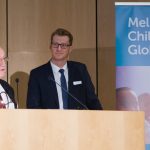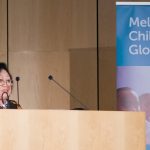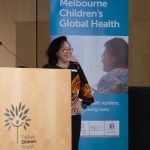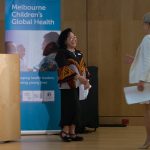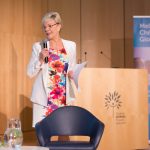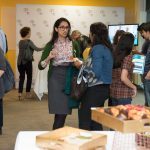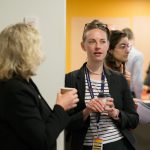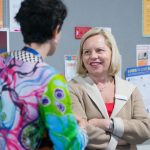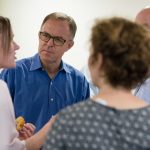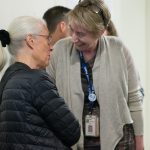Melbourne Children’s Global Health Annual Symposium
18th September 2019
|
| 8.30am – 3.30pm, Royal Children’s Hospital, 50 Flemington Road, Parkville |
|
|
| Thank you to everyone that attended the inaugural Melbourne Children’s Global Health Annual Symposium at the Royal Children’s Hospital on the 18th of September. The Symposium was a day packed full of dynamic and engaging discussions on key issues in global child and adolescent health, and we are very grateful to those who gave their time to share their knowledge and lead the discussions on the day. |
|
|
Student perspectives from the Annual Symposium:
Future vaccine successes demands strategy as well as science – Matthew Woodhouse
Vaccination is among the greatest success stories of modern medicine. Vaccines have made a huge contribution to reducing the burden of infectious diseases, with the eradication of smallpox and the near-elimination of polio being spectacular examples. Despite these many successes, there remains a high global burden of infectious diseases. Vaccine solutions to these persistent problems will require research and development of new vaccines, and mechanisms for sustainable production and delivery to those most in need.
Many of the relevant issues were discussed in a panel discussion at the Melbourne Children’s Global Health annual symposium, led by Dr Josh Osowicki with Professors Helen Evans and James McCarthy.
Associate Professor Evans, from the Nossal Institute at the University of Melbourne and formerly deputy director of Gavi the Vaccine Alliance, noted that traditional models of vaccine development have neglected low and middle income countries (LMIC), with industry being reluctant to invest in research, development and production of possibly unprofitable vaccines. Public-private partnerships, such as Gavi’s Advance Market Commitment (AMC) program, can offset this risk by negotiating lower vaccine costs for LMIC by guaranteeing purchase of large quantities. The AMC pilot included Gavi, several national governments, the Bill & Melinda Gates Foundation, World Bank, WHO and UNICEF testing the approach for pneumococcal vaccines. Streptococcus pneumoniae (pneumococcus) according to a 2005 WHO estimate kills up to 1.6 million children annually predominately in LMIC. Pneumococcal conjugate vaccines have been highly successful in preventing death due to S. pneumoniae in high income countries. In 2010 and 2011, the AMC pilot delivered conjugate pneumococcal vaccines to Latin America, Kenya, Yemen and Guyana and other developing countries. The pilot successfully met its targets for vaccine delivery and under 5 mortality fell during the intervention from 76 to 63 per 1,000 live births.
Professor James McCarthy, of QIMR Berghofer, discussed the relative value of investment in research and development of new products compared to implementation existing best practices in settings of greatest need. He focussed on malaria, highlighting the recent Lancet commission modelling showing that implementation of current best practices in diagnostics, treatment, and vector control would virtually eliminate malaria globally by 2050. To achieve outcomes like this, operational aspects of malaria programs must improve, community engagement must be prioritised, and data needs to be used to inform realistic and effective strategy.
The discussion which followed focused on the political and economic context in which vaccine development now occurs. Thanks to Dr Osowicki for facilitating such an engaging discussion, and professors McCarthy and Evans for their valuable contributions.
Volunteering in a LMIC: what you need to know about developing capacity – Aiden Varan
Dr Amy Gray chaired a reflective, provocative and powerful session on capacity building through volunteering and capacity building in low- and middle-income countries (LMICs) alongside panellists Ms. Emma Hess, Australian Volunteers International and Dr Titus Nasi, Head of Paediatrics at the National Referral Hospital in the Solomon Islands.
Reflecting on her extensive experience in Lao PDR and Vietnam, Dr Gray raised difficult and sometimes confrontational questions. Can a visiting clinician’s teaching workshop justify depleting local medical personnel from under-resources facilities? What happens when multiple teams deliver conflicting, or worse still irrelevant content (poignantly illustrated with an example of ventilator management training in a setting without ventilators)? Can we identify and challenge the title of “false white expert”, given presumed knowledge and skills based purely on skin colour?
However, she also painted a picture of the joy and richness in her work abroad – in transitioning from English tutor to ‘stealth’ medical educator in Vietnam, and in learning the art of patience in managing PhD commitments in Laos.
From this experience, Dr Gray highlighted five key attributes for successful volunteer work in LMICs:
Perspective – to justify the burden and benefit on any teaching or session delivered, noting the difficulty for recipients to refuse when offered
Adaptability: to adapt to roles given, however trivial they may seem
Curiosity: to constantly ask why
Persistence and patience: to recognise that change is hard, and local colleagues may feel weighed with other commitments
Humility and humour: to recognise what we as volunteers are and are not, and to always remain curious
As the Head of Paediatrics at Honiara’s National Referral Hospital, Dr Nasi has extensive experience hosting medical volunteers. For him, openness and honesty among visiting teams is critical. It was essential to be frank with volunteers about expectations, the realities of life ‘in the field’, and the gaps between.
One of the major challenges faced concerned the cycling of volunteers, and how to effectively absorb the rotating staff into the health system. Nasi described his longstanding relationship with Prof Trevor Duke (Director, Centre for International Child Health, University of Melbourne/Royal Children’s Hospital) as a critical asset, helping to screen and induct incoming volunteers to reduce the burden upon local staff. He also discussed the challenges of culture clash (both nationally and in the healthcare setting), communication difficulty and isolation that volunteers can face. Thus, adaptability was a crucial asset for success.
As Partnerships and Innovation Manager with Australian Volunteers, Ms Hess emphasized the importance of capacity building and sustainability in any LMIC volunteer initiative. To achieve meaningful change through volunteering requires strong local leadership, effective partnerships, and strategic planning to best utilise volunteer talent. Although there is a role for short-term projects, the focus should be put towards true partnership including multi-year strategic plans with partner organisations. Hence, identifying and collaborating effectively with partner organisations was a critical aspect of her work.
What about when, despite the best of intent, things go wrong with volunteers in the field? As the panellists noted, volunteers cannot control everything happening in their lives. Distressing family events combined with isolation from usual supports can prove challenging. Although technical expertise is key in delivering impactful capacity building, it is not enough to get someone through stressful situations. In moments of frustration, it is worth remembering that local staff have been frustrated for longer. If all else fails, Dr Gray suggests to invoke the power of a tantrum: to lie down and beat your hands and feet on the ground until you (inevitably) feel ridiculous!
Dr Gray ended the session with a challenge to the audience: would you only be willing to serve in a volunteer role in a LMIC if it lasted six or more months? The question stuck with me. Reflecting on my own experience in Uganda, I feel thankful that I had the time to build connections and trust, observe successes and failures, and gain perspective informing my subsequent global health work.
The sacrifices of long stays abroad are significant but the associated gains enormous. Are you prepared to take up this challenge? More importantly, can you bring the attributes and partnership to achieve true benefits for the recipients?
Child Health in Humanitarian Settings – Sarah Jackson
Just after a break for morning tea, attendees at the Melbourne Children’s Global Health Annual Symposium settled in to hear two amazingly qualified individuals chat about Child Health in Humanitarian Settings. Facilitated by Dr Hamish Graham, was both thought-provoking and awe-inspiring. Dr Kamalini Lokuge (Australian National University) and Dr Unni Krishnan (Save The Children), both spoke genuinely about their stories of involvement in paediatric humanitarian healthcare – an area of health provision that perhaps flies a little too under the radar. It is staggering to think that when war zones involve communities, five times the number of children die as fighters. Even in other humanitarian aid contexts such as climate events and famine, it is children that seem to bear the brunt of the health impact. These are children who, in addition to the normal physical and psycho-social challenges faced during childhood and adolescence, are faced with additional challenges, out of their control and their best interests for thriving.
Dr. Lokuge spent the beginning of her medical residency working in emergency medicine and paediatrics at a hospital in rural ACT, and twenty-five years ago was inspired to join MSF. Her first mission arose when a female doctor was required to run a health program in Kabul, Afghanistan, shortly after President Najibullah Ahmadzai was assassinated by the Taliban and the country was thrown into disarray. Dr. Lokuge was a superwoman, running multiple clinics, many of which were on the front line between the northern alliance and the Taliban. What came out of this was her realisation that healthcare, particularly for children in these settings, involves more than curing and treating. Healthcare provision in humanitarian settings must be entrenched in the complexity of the lives of those being treated. It involves having an impact that extends temporally past the clinic visit, and makes a real impact so that re-presentation is avoided. For Dr. Lokuge, this was her recognition of the severe malnutrition of the children she was treating, and her starting-up of a feeding program, despite little experience in this. She maintains to this day that because of the incredible and resilient people and communities she works with, she has the ‘best job in the world’, and that’s why twenty-five years down the track, she is still doing what she’s doing.
Dr. Krishnan’s story is just as phenomenal. Only a second-year medical student in 1984 India, Dr Krishnan skipped his final exams of the year to come to the aid of hundreds of thousands of children, women and men affected by a catastrophic chemical leak in central India. In early-eighties India, there was no internet, cell-phones or Wikipedia, and only one airline. Despite this, he made a trip to the disaster zone that was both medical-degree and life threatening. This humanitarian crisis was to kill 10,000 people, and damage or destroy the eye-sight of up to 500,000,000. Dr Krishnan wasn’t the only one naïve to the treatment protocols in this situation. He describes that ‘nobody knew what to do’. He was there, holding their hands in the last stages of life. After this, Krishnan was drawn to a career in Humanitarian healthcare. He knows now that it is not just this compassion he demonstrated so early on in his career that goes a long way in saving lives, but information too. Dr. Krishnan ‘has written more press releases and funding applications than prescriptions’ in his work for Save The Children – an organisation that works hard to get humanitarian health aid to children in need, within 72 hours. He puts it quite candidly that, ‘people in crisis have a right to receive assistance, and we have to provide it- humanity keeps us going’.
Both Dr. Lokuge and Dr. Krishnan have been involved in paediatrics in humanitarian settings for many years. How thinking about humanitarian action has evolved was raised by the audience. It was discussed that there is increasing recognition for children as survivors, not just victims. And that, in doing this, we provide more appropriate care and for a longer time, which evidence has shown helps children to thrive in the long-term. Furthermore, there is becoming a much-needed increase in focus on palliative care and pain relief of children, an area of healthcare that has been deliberately neglected for some time. The end of this session centred around empowering us, as healthcare workers with an interest in global child health, to continue to be advocates for paediatric dignity, and to give children a voice. This voice comes from respected professions and powerful organisations, with the ability to help shape political decisions on where finances should be distributed. Media and communications are fast becoming inseparable parts of the work we do; so grasping this to amplify the voice of the child is one of the most important things we can do within our professional lives to make a real impact where it is most needed.
Antimicrobial resistance – Sharon Sun
The Annual Symposium included a panel discussion, facilitated by A/Prof Penelope Bryant with presentations from A/Prof Steven Tong from the Doherty Institute and Dr Suman Majumdar from the Burnet Institute, on the global challenge of combating antimicrobial resistance.
According to the World Health Organisation (WHO), Antimicrobial Resistance (AMR) is defined as the ability of microorganisms (bacteria, viruses, fungi, and parasites) to stop an antimicrobial from working against it. As a result, standard treatments become ineffective, infections persist and may spread to others. Antimicrobial resistance has been gaining increasing attention in the recent decade, frequently appearing as news headlines. Estimates have predicted that there could be 10 million deaths by 2050 due to antimicrobial resistance. Currently antibiotics are frequently overused in low and middle-income countries due to lack of information and awareness. One would expect the situation would be better in Australia; however, there is still overuse of antibiotics in our communities. In Australia, amongst all age groups, antibiotics are most frequently used in children, which is a critical growth period for us as humans, and this potentially has long-term health effects, including the effect on microbiome. Fortunately there are relatively low rates of antibiotic resistance among children.
In order to minimise antimicrobial resistance, the World Health Organisation (WHO) has initiated a Global Action Plan which includes awareness and education, surveillance of antimicrobial resistance, infection prevention and control, and optimal use of antimicrobial medicine in humans and animal health. In Australia, the National Centre for Antimicrobial Stewardship (NCAS) promotes the rational use of antibiotics. It aims to optimise the use of antimicrobial therapies and minimise the impact of antimicrobial resistance.
Two different research projects were presented at the Annual Symposium. The first project was conducted by A/Prof Steve Tong regarding MRSA (methicillin-resistant Staphylococcus aureus) in Northern Australia. Research has shown at the Royal Children Hospital, the rate of MRSA is around 6-10%, however, in remote areas of Australia such as Far North Queensland and Northern Territory, the rate of infection is much higher. Based on the results of genomic studies, MRSA emerges in the Northern Territory and can spread to the rest of Australia. The other study led by Dr Suman Majumdar was on multi-drug resistant tuberculosis (MDR-TB) in Daru of Papua New Guinea (PNG). 2.3% of that population develop tuberculosis (TB). A genome study was done to identify case of MDR-TB. By screening the whole community in Daru, latent TB was able to be treated with a drop in MDR-TB.
The panel also answered questions from the guidance regarding AMR. The single biggest challenge when managing antibiotic resistance is that there is a lack of data to inform what can be done next to combat this global health challenge, particularly in areas with massive inequalities. The panel also identified the biggest solution for AMR will still be awareness, particularly amongst Aboriginal and Torres Strait Islanders in Australia and in low and middle income countries. The panel members pointed out that there is increasing awareness about antibiotics use in community. It has been noticed that increasing number of parents would say that they didn’t want antibiotics to treat viral infections in their children. Antimicrobial resistance remains a challenge for the global health community, and one that will need international collaboration and effort to resolve.
Women in global health – Olivia Baenziger
The last session of the Melbourne Children’s Global Health Annual Symposium – Women in Global Health – explored both roles and health outcomes for women in global health. A stellar panel of three women was facilitated by Associate Professor Margie Danchin. A/Prof Danchin is director of Clinician Scientist Pathways at the University of Melbourne and has long standing experience in vaccination research and paediatrics.
Panellist Dr Stephanie Williams provides strategic and technical advice at the Department of Foreign Affairs and Trade under her role as Principal Health Sector Specialist. Dr Williams has extensive global experience as a public health physician and provided unique insights into the political and governmental nature of global health aid. The emerging recognition of the importance of adolescent health, particularly for women, was enforced by having Professor Susan Sawyer on the panel. Prof Sawyer is director for Adolescent Health at the Royal Children’s Hospital and chair of Adolescent Health at the Department of Paediatrics at the University of Melbourne. Dr Meghan Bohren was a fantastic final member to have on the panel, leading research investigating the maternal healthcare experiences for women in low- and middle- income countries. Under the School of Population and Global Health at the University of Melbourne, Dr Meghan Bohren is a senior lecturer in Gender and Women’s health.
The format of the session enabled discussion of a range of topics – from female genital mutilation to menstrual product disposal at schools. The four main spaces of women’s global health dialogue included; health issues, gender empowerment, leadership and global governance. The panel discussed the range of global health issues pertaining to adolescent girls and women: exposure to risks and adverse health outcomes are woven into the social fabric to which a woman belongs to. Poverty, mental health, violence and intergenerational structuring are few of the issues that pertain to health disparities. Prof Sawyer emphasised that health differentiation can change quickly across adolescence and that “life is gendered from birth […] particularly from the time of puberty”. Investments in educating adolescent girls is thought to be critical to women’s health and tied into the powerful movement of empowering women.
Gender equality, empowerment and decision making in women’s health: ‘I have heard a mother say to her pregnant daughter “you didn’t cry making this baby, so you’re not going to cry now”. This story was one that resonated with experiences of the panel and the audience. All panellists supported the engagement of adolescent girls and women in their own decisions about healthcare. Women’s health literacy is an area of increasing investment and importance, and can be a powerful protector of emotional and physical health and wellbeing.
There is a growing recognition and encouragement for women to enter and foster global health leadership positions, with new initiatives to support women in global health. Although not yet finalised, a local application is underway to form an official Australasian chapter of Women in Global Health (https://www.womeningh.org/). With traction for change and the demand for equal representation, women have found seats at the highest of tables and levels of decision making in global health governance. However, the panel discussed the next step to move beyond simply enforcing proportions in guideline groups and decision-making panels.
In so many parts of the world, access to healthcare is challenged by the law, political context and community norms, many of which are embodied by health professionals. The panel placed weight on credible health leadership as a starting point to deliver health and support women – notwithstanding challenges providing a comprehensive approach, there is an urge for strong voices at a policy level. Ultimately, women’s health is a multilateral system and everyone’s business.
|
Program
8.30 – 8.45 Registration
8.45 – 9.00 Welcome – Professor Andrew Steer
9.00 – 9.30 Innovative models to accelerate vaccine development
Facilitator: Dr Joshua Osowicki
Panel: Professor James McCarthy (University of Queensland)
Associate Professor Helen Evans AO (Nossal Institute for Global Health)
9.30 – 10.00 Reaching the unreached– understanding the neglected needs of adolescents
Facilitator: Dr Peter Azzopardi
Panel: Professor Jane Fisher (Monash University)
Dr Kathryn Snow (University of Melbourne),
Dr Cathy Vaughn (University of Melbourne)
10.00-10.30 Volunteering in a LMIC: what you need to know about developing capacity
Facilitator: Dr Amy Gray
Panel: Emma Hess (Australian Volunteers International)
Dr Titus Nasi (Solomon Islands Ministry of Health)
10.30 – 11.00 Morning tea
11.00 – 11.30 Child health in humanitarian settings
Facilitator: Dr Hamish Graham
Panel: Dr Unni Krishnan (Save The Children)
Dr Kamalini Lokuge (Australian National University)
11.30 – 12.00 Antimicrobial resistance
Facilitator: Associate Professor Penelope Bryant
Panel: Dr Suman Majumdar (Burnet Institute)
Associate Professor Steve Tong (Doherty Institute)
12.00-12.30 Lunch
12.30 – 1.30 Melbourne Children’s Campus Grand Rounds
Dr Stephanie Williams, Principal Sector Specialist for Health, Australian Government
Department of Foreign Affairs and Trade
1.30 – 2.30 Women in Global Health
Facilitator: Associate Professor Margie Danchin
Panel: Prof Susan Sawyer
Dr Meghan Bohran
Dr Stephanie Williams
2.30 – 3.30 Afternoon tea and networking |
|
|
|
|

